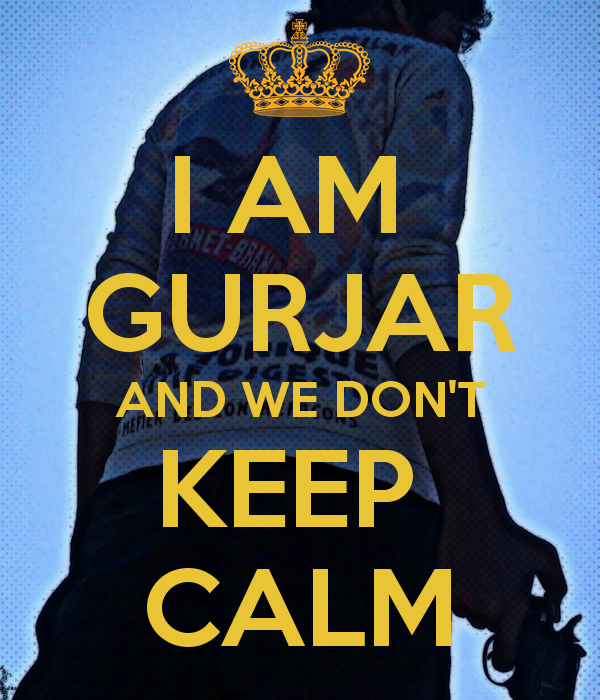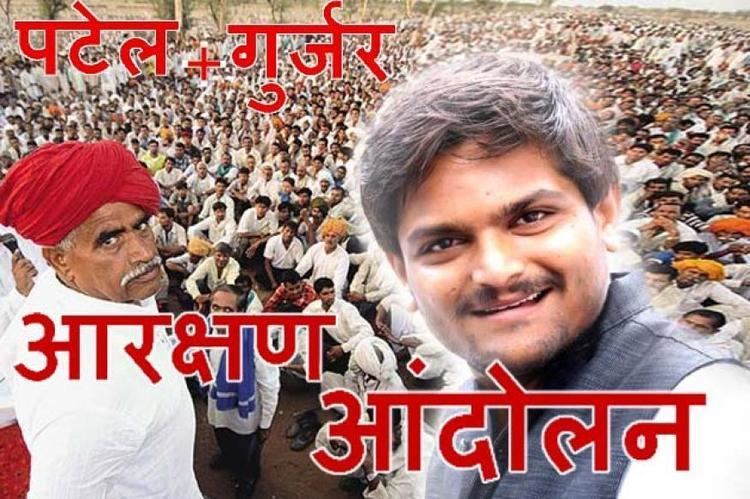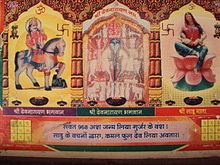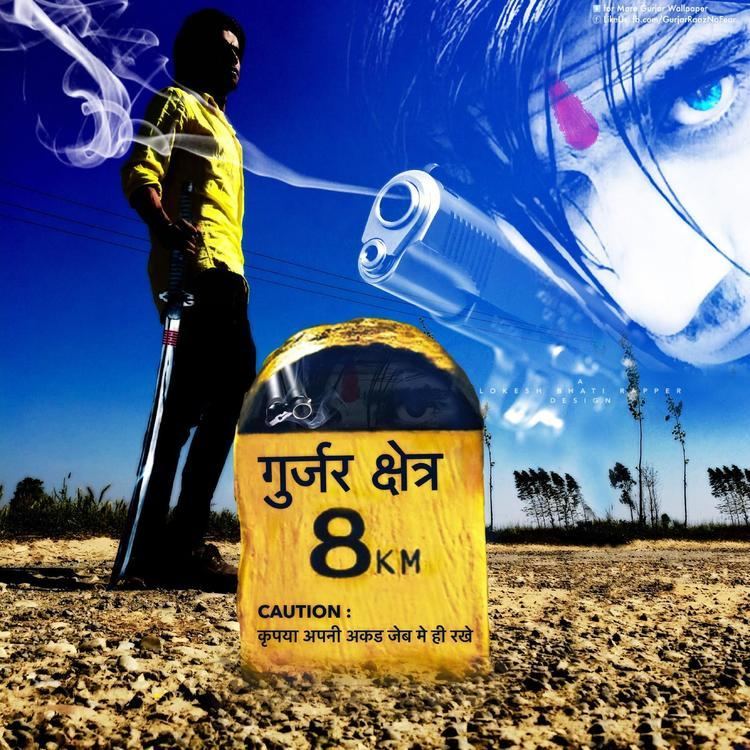 | ||
Gurjar or Gujjar are a pastoral agricultural ethnic group with populations in India and Pakistan and a small number in northeastern Afghanistan. Alternative spellings include Gurjara, Gurjjar, Gojar and Gūjar. Although they are able to speak the language of the country where they live, Gurjars have their own language, known as Gujari. They variously follow Hinduism, Islam, and Sikhism. The Gurjars are classified as Other Backward Class (OBC) in some states in India; however, Gurjars in Jammu and Kashmir and parts of Himachal Pradesh are categorised as a Scheduled Tribe. Hindu Gurjars were assimilated into various varnas in the medieval period.
Contents
- Origin
- Gurjar rulers
- British rule
- Afghanistan
- India
- Haryana
- Rajasthan
- Madhya Pradesh
- Gujarat and Maharashtra
- Himachal Pradesh
- Jammu and Kashmir
- Van Gurjars
- References

Origin

Historians and anthropologists differ on issue of Gurjar origin. According to one view, Gurjars came from central Asia via Georgia from near the Caspian Sea; that Sea's alternate name of the Bahr-e-Khizar caused the tribe to be known as Khizar, Guzar, Gujur, Gurjara, or Gujjar. According to this view, Gurjars came in multiple waves of migration and they were initially accorded status as high-caste warriors in the Hindu fold in the North-Western regions (modern Rajasthan and Gujarat). Aydogdy Kurbanov states that some Gurjars, along with people from northwestern India, merged with the Hephthalites to become the Rajput clan.

According to scholars such as Baij Nath Puri, the Mount Abu (ancient Arbuda Mountain) region of present-day Rajasthan had been abode of the Gurjars during medieval period. The association of the Gurjars with the mountain is noticed in many inscriptions and epigraphs including Tilakamanjari of Dhanpala. These Gurjars migrated from the Arbuda mountain region and as early as in the 6th century A.D., they set up one or more principalities in Rajasthan and Gujarat] Whole or a larger part of Rajasthan and Gujarat had been long known as Gurjaratra (country ruled or protected by the Gurjars) or Gurjarabhumi (land of the Gurjars) for centuries prior to the Mughal period.

In Sanskrit texts, the ethnonym has sometimes been interpreted as "destroyer of the enemy": gur meaning "enemy" and ujjar meaning "destroyer").

In its survey of The People of India, the Anthropological Survey of India (AnSI) – a government-sponsored organisation – noted that
The Gurjars/Gujjars were no doubt a remarkable people spread from Kashmir to Gujarat and Maharashtra, who gave an identity to Gujarat, established kingdoms, entered the Rajput groups as the dominant lineage of Badgujar, and survive today as a pastoral and a tribal group with both Hindu and Muslim segments.
Irawati Karve, the Indologist and historian, believed that the Gurjars position in society and the caste system generally varied from one linguistic area of India to another. In Maharashtra, Karve thought that they were probably absorbed by the Rajputs and Marathas but retained some of their distinct identity. She based her theories on analysis of clan names and tradition, noting that while most Rajputs claim their origins to lie in the mythological Chandravansh or Suryavansh dynasties, at least two of the communities in the region claimed instead to be descended from the Agnivansh.
A 2009 study conducted by Tribal Research and Cultural Foundation, under the supervision of Gurjar scholar Javaid Rahi, claimed that the word "Gojar" has a Central Asian Turkic origin, written in romanized Turkish as Göçer. The study claimed that according to the new research, the Gurjar race "remained one of the most vibrant identity of Central Asia in BC era and later ruled over many princely states in northern India for hundred of years."
Gurjar rulers
D. B. Bhandarkar believed that Gurjara-Pratiharas were a clan of Gurjars. Dasrath Sharma believed that although some sections of the Pratiharas (i.e., the one to which Mathanadeva belonged) were Gurjars by caste, the Pratiharas of Kannauj were not Gurjars and there was no Gurjara empire in Northern India in 8th and 9th century.
British rule
In the 18th century, several Gurjar chieftains and small kings were in power. During the reign of Rohilla Nawab Najib-ul-Daula, Dargahi Singh, the Gurjar chieftain of Dadri possessed 133 villages at a fixed revenue of Rs.29,000. A fort at Parlchhatgarh in Meerut District, also known as Qila Parikishatgarh, is ascribed to a Gurjar Raja Nain Singh.
During the revolt of 1857, the Gurjars of Chundrowli rose against the British, under the leadership of Damar Ram. The Gurjars of Shunkuri village, numbering around three thousand, joined the rebel sepoys. According to British records, the Gurjars plundered gunpowder and ammunition from the British and their allies. In Delhi, the Metcalfe House was sacked by Gurjar villagers from whom the land was taken to erect the building. The British records claim that the Gurjars carried out several robberies. Twenty Gurjars were reported to have been beheaded by Rao Tula Ram for committing dacoities in July 1857. In September 1857, the British were able to enlist the support of many Gurjars at Meerut. The colonial authors always used the code word "turbulent" for the castes who were generally hostile to British rule. They cited proverbs that appear to evaluate the caste in an unfavorable light. A British administrator, William Crooke, described that Gurjars seriously impeded the operations of the British Army before Delhi. Reporter Meena Radhakrishna believe that the British classified the Gurjars along with others as "criminal tribes" because of their active participation in the revolt of 1857, and also because, they considered these tribes to be prone to criminality in the absence of legitimate means of livelihood.
Afghanistan
Small pockets of Gurjars are found in Afghanistan's northeastern region, particularly in and around the Nuristan province. According to the Naval Postgraduate School:
They roam with their herds, usually of cows, from the high Himalayas in India to the Hindu Kush of Afghanistan, although rarely are they seen in Afghanistan anymore, as Pakistan has hindered their passage through its territory and most preferred to stay within India. Some in India remain Hindu, although further west many are Muslim. Often they can be recognized by their avoidance of others, and their brightly hennaed beards. They are proud, fierce, and loyal. Their traditions are millennia old, and they have preserved them well in the face of great adversity. They are somewhat related to Nuristanis, although exactly how is a subject of conjecture. Similar to Nuristanis, some genetic root gives many Gurjars a distinctly European appearance, up to and including blond hair and blue eyes.
India
Today, the Gurjars are classified under the Other Backward Class category in some states in India. However, in Jammu and Kashmir and parts of Himachal Pradesh, they are designated as a Scheduled Tribe under the Indian government's reservation program of positive discrimination. Hindu Gurjars were assimilated into several varnas.
Haryana
The Gurjar community in Haryana has set elaborate guidelines for solemnizing marriages and holding other functions. In a mahapanchayat ("the great panchayat"), the Gurjar community decided that those who sought dowry would be excommunicated from the society.
Rajasthan
Songs pertaining to Krishna and Gurjars were documented in Gurjar-inhabited areas during the British Raj, the connection being that Nand Mihir, the foster-father of Krishna, is claimed to be a Gurjar. Radha, the consort of Krishna, was also a Gurjar.
The Rajasthani Gurjars worship the Sun God, Devnarayan (an avatar of Vishnu), Shiva and Bhavani.
In Rajasthan, some members of the Gurjar community resorted to violent protests over the issue of reservation in 2006 and 2007. During the 2003 election to the Rajasthan assembly, the Bharatiya Janata Party (BJP) promised them ST status. However, the party failed to keep its promise after coming to the power, resulting in protests by the Gurjars in September 2006.
In May 2007, during violent protests over the reservation issue, the members of the Gurjar community clashed with the police twenty six people (including two policemen). Subsequently, the Gurjars protested violently, under various groups including the Gurjar Sangarsh Samiti, Gurjar Mahasabha and the Gurjar Action Committee. The protestors blocked roads and set fire to two police stations and some vehicles. Presently, the Gurjars in Rajasthan are classified as Other Backward Classes.
On 5 June 2007, Gurjars rioted over their desire to be added to the central list of tribes who are given preference in India government job selection as well as placement in the schools sponsored by the states of India. This preference is given under a system designed to help India's poor and disadvantaged citizens. However, other tribes on the list oppose this request as it would make it harder to obtain the few positions already set aside.
In December 2007, the Akhil Bhartiya Gurjar Mahasabha ("All-India Gurjar Council") stated that the community would boycott BJP, which is in power in Rajasthan. But now in 2009 all Gurjars were supporting BJP so that they can be politically benefitted.Kirori Singh Bainsla fought and lost at BJP ticket. In early 2000s (decade), the Gurjar community in Dang region of Rajasthan was also in news for the falling sex ratio, unavailability of brides, and the resulting polyandry.
Madhya Pradesh
As of 2007, the Gurjars in Madhya Pradesh are classified as Other Backward Classes.
Gujarat and Maharashtra
A few scholars believe that the Leva Kunbis (or Kambis) of Gujarat, a section of the Patidars, are possibly of Gurjar origin. However, several others state that the Patidars are Kurmis or Kunbis (Kanbis); the National Commission for Backward Classes of India lists Leva Patidars (or Lewa Petidars) as a sub-caste of Kunbis/Kurmis. Dode Gujars and Dore Gujars are listed as separate caste in Maharashtra and Gurjars are included in OBC list in Gujarat but Patidars are not.
Himachal Pradesh
As of 2001, the Gurjars in parts of Himachal Pradesh were classified as a Scheduled Tribe.
Jammu and Kashmir
In the Indian state of Jammu and Kashmir, the concentration of Muslim Gurjars is observed in the districts of Rajouri and Poonch, followed by, Ananatnag, Udhampur and Doda districts. It is believed that Gurjars migrated to Jammu and Kashmir from Gujarat (via Rajasthan) and Hazara district of Khyber Pakhtunkhwa. Another group called Bakarwal (or Bakerwal) belongs to the same ethnic stock as the Gurjars, and inter-marriages freely take place among them.
As of 2001, the Gurjars and the Bakarwals in Jammu and Kashmir were classified as Scheduled Tribes. According to the 2001 Census of India, Gurjar is the most populous scheduled tribe in J&K, having a population of 763,806. Around 99.3 per cent population of Gurjar and Bakarwal in J&K follow Islam.
The Gurjars of Jammu and Kashmir in 2007 demanded to treat this tribal community as a linguistic minority in the State and provide constitutional safeguards to their language Gojri. They also impressed upon the state government to take up the matter with Delhi for inclusion of Gojri in the list of official languages of India.
In 2002, some Gurjars and Bakarwals in J&K demanded a separate state (Gujaristan) for Gurjar and Bakarwal communities, under the banner of All India Gurjar Parishad.
Van Gurjars
The Van Gurjars ("forest Gurjars") are found in the Shivalik hills area of North India. The Van Gurjars follow Islam, and they have their own clans, similar to the Hindu gotras. They are a pastoral semi-nomadic community, practising transhumance. In the winter season, the Van Gurjars migrate with their herds to the Shiwalik foothills, and in summer, they migrate to pastures high up in the mountains. The Van Gurjars have had conflicts with the forest authorities, who prohibited human and livestock populations inside a reserved park, and blamed the Van Gurjar community for poaching and timber smuggling. After the creation of the Rajaji National Park (RNP), the Van Gurjars in Deharadun were asked to shift to a resettlement colony at Pathari near Hardwar. In 1992, when they returned to the foothills, the RNP authorities tried to block them from the park area. The community fought back and finally the forest authorities had to relent. Later, a community forest management (CFM) programme aiming to involve the Van Gurjars in forest management was launched.
